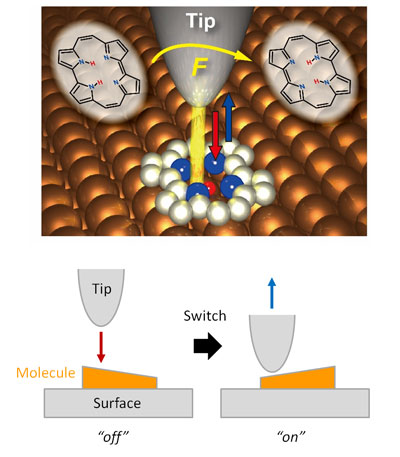Molecular Switches: Nanoscale Control and Responsiveness
What are Molecular Switches?
Molecular switches are nanoscale devices that can reversibly change their state or conformation in response to external stimuli. These switches are typically individual molecules or molecular assemblies that exhibit distinct properties in each state, allowing them to function as binary logic elements, similar to electronic switches in conventional circuits.

Key Features of Molecular Switches
Molecular switches possess several unique features that distinguish them from macroscopic switches:
- Nanoscale Size: Molecular switches operate at the nanoscale, with typical dimensions ranging from a few angstroms to several nanometers. This miniaturization enables the development of high-density, low-power, and fast-responding devices.
- Stimuli-Responsive: Molecular switches respond to various external stimuli, such as light, electricity, pH, temperature, or chemical species. The specific stimulus induces a change in the molecular structure or electronic configuration, leading to a switch in the device's state.
- Reversibility: The switching process in molecular switches is typically reversible, allowing the device to toggle between states multiple times. The reversibility is crucial for applications that require dynamic control and reconfigurability.
- Property Modulation: Each state of a molecular switch exhibits distinct properties, such as electrical conductivity, optical absorption, or magnetic moment. These properties can be exploited for various applications, such as information processing, sensing, and actuation.
Types of Molecular Switches
Molecular switches can be classified based on the type of external stimulus that triggers the switching process:
Photochromic Switches
Photochromic switches undergo a reversible change in their molecular structure and electronic properties upon exposure to light. Common examples include azobenzenes, diarylethenes, and spiropyrans. These switches find applications in optical data storage, photopharmacology, and smart materials.
Electrochemical Switches
Electrochemical switches respond to changes in electrical potential or current. These switches often involve redox-active molecules, such as viologens or tetrathiafulvalenes, that can reversibly accept or donate electrons. Electrochemical switches are used in molecular electronics, energy storage, and electrochromic devices.
pH-Responsive Switches
pH-responsive switches change their state in response to variations in the acidity or basicity of the environment. These switches typically contain functional groups that can be protonated or deprotonated, such as amines or carboxylic acids. pH-responsive switches are useful for drug delivery, sensing, and smart materials.
Mechanically Interlocked Switches
Mechanically interlocked molecular switches, such as rotaxanes and catenanes, consist of two or more components that are physically linked but not covalently bonded. The relative motion of these components, triggered by external stimuli, results in a change in the switch's state. These switches are promising for molecular machines and nanoelectromechanical systems (NEMS).
Design and Synthesis of Molecular Switches
The design and synthesis of molecular switches involve a multidisciplinary approach combining organic synthesis, supramolecular chemistry, and computational modeling. The key steps include:
- Identifying the desired switching mechanism and the corresponding external stimulus.
- Designing the molecular structure that can undergo the desired conformational or electronic changes upon exposure to the stimulus.
- Synthesizing the molecular switch using organic synthesis techniques, such as coupling reactions, cyclizations, or functional group transformations.
- Characterizing the molecular switch using spectroscopic and analytical techniques to confirm its structure, purity, and switching properties.
- Integrating the molecular switch into a device or system for practical applications.
Computational modeling plays a crucial role in predicting the switching behavior, optimizing the molecular design, and understanding the structure-property relationships. Techniques such as density functional theory (DFT) and molecular dynamics simulations provide valuable insights into the electronic structure, conformational changes, and stimuli-responsiveness of molecular switches.
Applications of Molecular Switches
Molecular switches find applications in various fields, leveraging their nanoscale control and responsiveness:
Molecular Electronics
Molecular switches are the building blocks for molecular electronics, where individual molecules or molecular assemblies perform the functions of electronic components. These switches can be used to create high-density memory devices, logic gates, and molecular transistors, enabling the development of ultra-small and low-power electronic circuits.
Drug Delivery
Stimuli-responsive molecular switches can be incorporated into drug delivery systems to achieve controlled release of therapeutic agents. For example, pH-responsive switches can be designed to release drugs in specific environments, such as the acidic conditions found in tumor tissues or intracellular compartments.
Sensors and Actuators
Molecular switches can be employed as highly sensitive sensors for detecting specific analytes or environmental conditions. The switching event can be coupled with a measurable output, such as a change in fluorescence or electrical conductivity. Additionally, molecular switches can be integrated into actuators, where the switching process induces a mechanical motion or deformation.
Smart Materials
Molecular switches can be incorporated into materials to impart stimuli-responsiveness and adaptability. For instance, photochromic switches can be used to create smart windows that darken or lighten in response to sunlight, while pH-responsive switches can be used to develop self-healing materials or adaptive surfaces.
Challenges and Future Perspectives
Despite the significant progress in the field of molecular switches, several challenges need to be addressed for their widespread adoption. One of the main challenges is the integration of molecular switches into practical devices and systems. The scalable fabrication, addressability, and interfacing of molecular switches with macroscopic components remain significant hurdles.
Future research in molecular switches will focus on the development of novel switching mechanisms, multi-stimuli responsiveness, and improved stability and durability. The integration of molecular switches with other nanoscale components, such as nanoparticles, nanotubes, or 2D materials, will enable the creation of hybrid devices with enhanced functionality. Additionally, the exploration of quantum effects in molecular switches may lead to the development of quantum information processing and quantum sensing applications.
Further Reading
Surface Science Rports, Molecular switching on surfaces
Annual reviews, Molecular Switches and Motors on Surfaces
